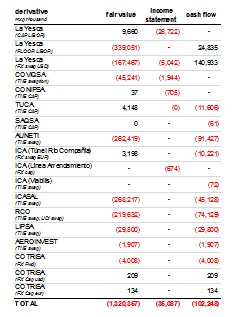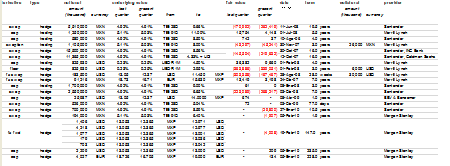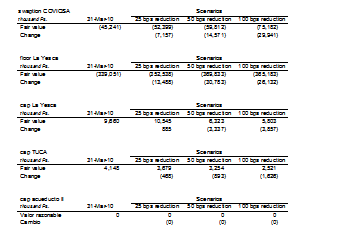FORM 6-K
SECURITIES AND EXCHANGE COMMISSION
Washington, D.C. 20549
Report of Foreign Private Issuer
Pursuant to Rule 13a-16 or 15d-16
of the Securities Exchange Act of 1934
For the month of April, 2010
Commission File Number 1-11080
THE ICA CORPORATION
(Translation of registrant's name into English)
Blvd. Manuel Avila Camacho 36
Col. Lomas de Chapultepec
Del. Miguel Hidalgo
11000 Mexico City
Mexico
(Address of principal executive offices)
Indicate by check mark whether the registrant files or will file annual reports under cover Form 20-F or Form 40-F.
Form 20-F.....x.... Form 40-F.........
Indicate by check mark if the registrant is submitting the Form 6-K in paper as permitted by Regulation S-T Rule 101(b)(1): ____
Indicate by check mark if the registrant is submitting the Form 6-K in paper as permitted by Regulation S-T Rule 101(b)(7): ____
Indicate by check mark whether by furnishing the information contained in this Form, the registrant is also thereby furnishing the information to the Commission pursuant to Rule 12g3-2(b) under the Securities Exchange Act of 1934.
Yes ..... No...x...
If "Yes" is marked, indicate below the file number assigned to the registrant in connection with Rule 12g3-2(b): 82- ________
(translation)
File 151.112.32
NATIONAL BANKING AND SECURITIES COMMISSION
LIC. RAFAEL COLADO IBARRECHE
Chief Supervisor of Issuers
LIC. ANDREA FABIOLA TINOCO H.
Chief Supervisor for Compliance with Stock Market Supervision
Mexico City, April 26, 2010
RE: 151-2/76211/2009
LUIS CARLOS ROMANDÍA, acting in my capacity as legal representative of Empresas ICA S.A.B. de C.V. (ICA or “the Issuer”) with an address for notifications located at Blvd. Manuel Ávila Camacho No. 36, 15th floor, Col. Lomas de Chapultepec, 11000, Mexico City, Federal District, and being duly registered before the National Banking and Securities Commission (CNBV) respectfully appear and state the following:
On January 20, 2009 I was notified of Order No. 151-2/76211/2009, File 151.112.32 which requested that ICA disclose qualitative and quantitative information regarding ICA’s exposure to financial derivative instruments, whether to increase profitability or to hedge risks, in order to provide investors information that would allow them to understand ICA’s operations with financial derivative instruments.
Based on the foregoing requirement, we state the following:
III. Qualitative and Quantitative Information
i) ICA only contracts hedging instruments in order to reduce the uncertainty on the return on its projects. It is the policy to contract financial instruments at the level of the project in order to mitigate the risks resulting from interest rates and exchange rate fluctuations. From an accounting perspective, the derivative instruments may be classified as hedging instruments or trading instruments, although in all cases the objective is to mitigate risks to which ICA is exposed in its projects.
Interest rate hedges are established based on a notional value with the objective to cap maximum financial costs.
Exchange rate hedges are contracted to ensure that the project will have sufficient resources for labor costs and inputs that are incurred in currencies different from those provided by the financing of the project, which is in the same currency as the source of repayment. ICA contracts all derivatives in the subsidiaries where the projects are located.
The contracting of financial derivatives is linked to the financing of projects, as a result of which it is often the case that the counterparty is the same institution that is providing the financing or one of its affiliates (e.g., Banco Santander, Goldman Sachs, Merrill Lynch, Banamex, ING Bank, Morgan Stanley). These derivatives are non exchange traded (OTC) derivatives.
Our internal control policies state that the contracting of credits (tied to the financing of projects) and the risks inherent in the projects require collaborative analysis by representatives from the Finance, Law, Administration, and Operations areas, prior to any approval. This analysis also includes the use of derivatives to hedge the risks of the financing. Once this analysis has been concluded and documented, the responsibility for contracting derivates belongs to the Finance area, in accordance with internal control policy.
The decision to contract derivative financial instruments is linked to the amount and level of financing for the project. The levels of authorization do not expressly contemplate requiring the authorization of the Corporate Practices or Audit Committees. With respect to approval authorization levels, ICA has documented policies, of which the most important are the following:
| § | The Chief Executive Officer, the Vice President for Finance and Administration, and/or the responsible Finance officer have limits on their authorities to act, whether in terms of amounts or for unusual or non-recurring operations. |
| § | The Chief Executive Officer has the authority to establish limits on the approval authorities of other Officers in terms of amounts or kind of operation. |
| § | In the event that a higher level of authorization is required, the Board of Directors will make the approval, after considering the opinion of the Chief Executive Officer and/or the applicable Committees. |
The derivatives that are contracted do not have margin calls, in accordance with what is negotiated with each counterparty. For those projects that require collateral, the policy is that any required deposits be made or standby letters of credit be provided at the time of contracting the derivative. This collateral will only be payable in the event of non-compliance.
In accordance with the standards of the International Swaps and Derivatives Association (ISDA), it is agreed that counterparties may act as valuation or calculation agents, in order to determine fair value and required payments.
While there is no formal risk committee, as previously stated various areas participate in the evaluation, administration, and monitoring of project risks (both financial and operational). As regards risk administration, there are documented processes that require the periodic review of risks.
ii) ICA uses the valuations of counterparties (valuation agents) and a price provider authorized by the CNBV in order to calculate the fair value of derivative positions for accounting purposes. The valuations are made using formal, documented methodologies.
Fair value is recognized in the balance sheet as an asset or liability, in accordance with the rights or obligations derived from the contracts executed and in accordance with accounting norms. Changes in fair value are recorded in the balance sheet. In addition to the valuations that are received, the pricing provider carries out tests of effectiveness for the derivatives that qualify as hedging instruments from an accounting perspective.
As previously mentioned, occasionally derivatives contracted as hedges do not qualify for accounting treatment as hedging instruments, and are classified as trading derivatives for accounting purposes. In these cases, the fluctuation in fair value on these derivatives is recognized in the results of the period.
iii) ICA has a policy of contracting derivatives instruments at the project level and not contracting instruments that have margin call or additional credit requirements beyond those authorized by the responsible committees at the time of approval.
iv) Based on the interest rate and exchange rate projections recently issued by Banco de México, and assuming these rates are maintained, the Issuer does not expect to suffer any material adverse impact from its derivative positions on its results of operations for the second quarter of 2010 as a result of additional changes in the peso or changes in interest rates since March 31, 2010.
In accordance with your request for this section, we set forth below the derivatives that matured during the quarter.
The following were the effects of derivative transactions as of March 31, 2010:
v) Table 1 presents the information requested regarding all material instruments that the Issuer currently has outstanding through project companies, including subsidiaries and affiliates.
IV. SENSITIVITY ANALYSIS
The derivatives instruments identified in the table above as hedging derivatives were excluded from the sensitivity analysis because they do not show any ineffectiveness.
| § | With respect to UDI swaps and the swaptions, losses are presented under three scenarios: |
| a) | 25 bp reduction in interest rates |
| b) | 50 bp reduction in interest rates |
| c) | 100 bp reduction in interest rates |
In conclusion, on aggregating the potential losses under the different scenarios described above for the position analyzed, the following results obtain:
Compared to balance sheet concepts and revenues, one can appreciate that under no scenario, is the effect more than 5% of assets, liabilities, or shareholders’ equity as of March 31, 2010, as shown below. The threshold of 3% of revenues is not exceeded under any scenario as well.
In virtue of the foregoing, the undersigned respectfully submits to the National Banking and Securities Commission:
FIRST. I have responded on time and in the appropriate manner, and with the authorities granted to me.
SECOND. I have delivered the information required in your Order No. 151-2/76211/2009.
Mexico City, April 26, 2010
________________________________________
Empresas ICA S.A.B. de C.V.
By: Luis Carlos Romandía García
Position: Legal Representative
SIGNATURE
Pursuant to the requirements of the Securities Exchange Act of 1934, the registrant has duly caused this Report to be signed on its behalf by the undersigned, thereunto duly authorized.
Date: April 26, 2010
| Empresas ICA, S.A.B. de C.V. | |
| | /s/ JOSE LUIS GUERRERO ALVAREZ |
| | Name: José Luis Guerrero Alvarez |
| | Title: Chief Executive Officer |
| | | |





